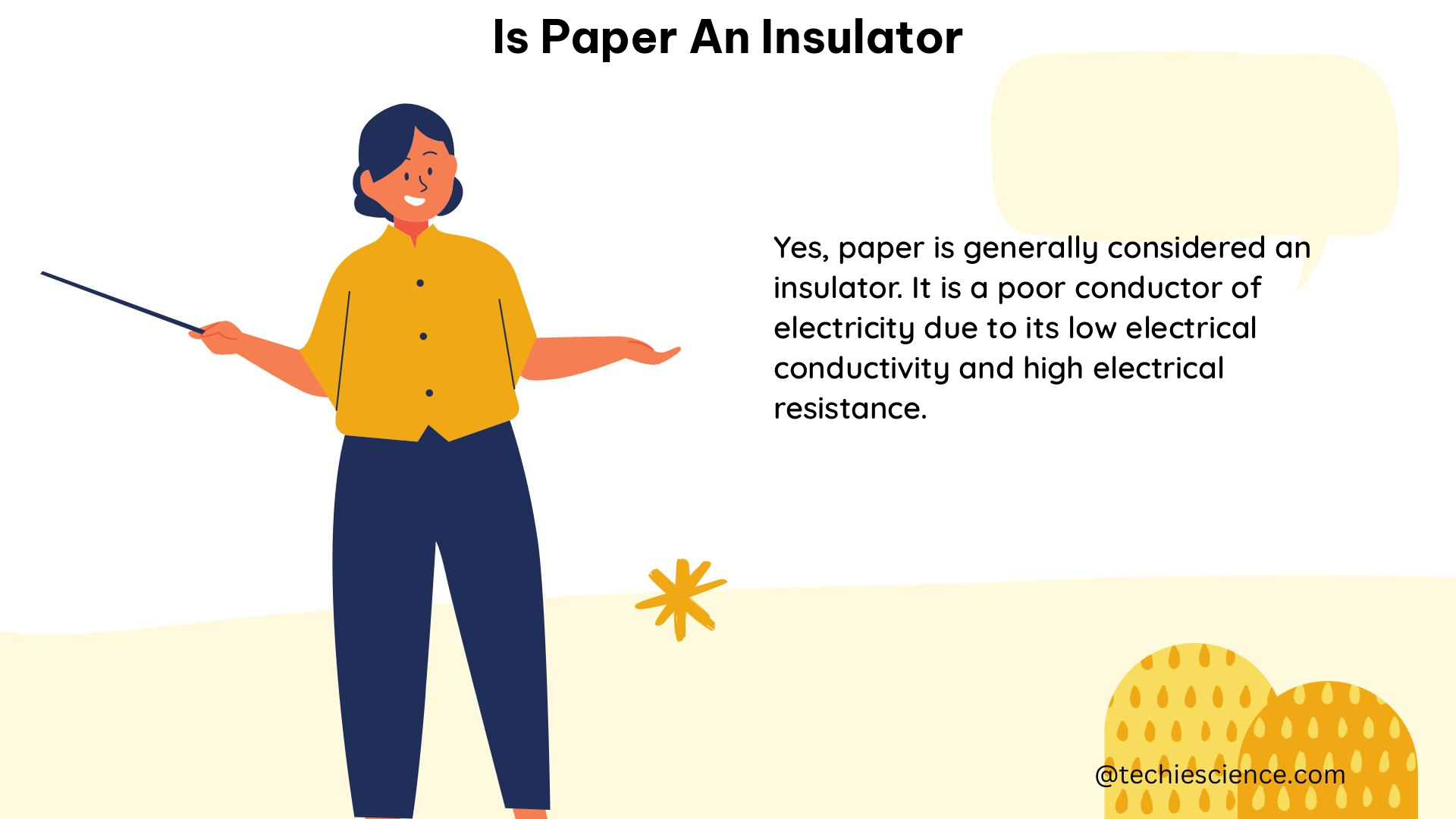Summary
Paper is a widely used material that exhibits insulating properties, making it an important consideration in various applications, from building construction to electrical engineering. The insulating performance of paper can be quantified through the measurement of its thermal conductivity coefficient (λ), which is a key parameter in assessing the efficiency of insulation materials. This comprehensive guide delves into the technical details and quantifiable data points that characterize the insulating properties of paper, providing physics students with a valuable resource for understanding and optimizing the use of this versatile material.
Understanding Thermal Conductivity Coefficient (λ)

The thermal conductivity coefficient (λ) is a fundamental property that determines the insulating performance of a material. It is a measure of the rate at which heat is transferred through a material, with lower values indicating better insulation performance. For paper, the thermal conductivity coefficient is typically measured using specialized instruments, such as the λ-Meter EP500e guarded hot plate equipment.
Factors Influencing Thermal Conductivity Coefficient
-
Density: Studies have shown that the thermal conductivity coefficient of paper increases as the density of the material increases. This means that denser paper samples generally have poorer insulation performance compared to less dense samples.
-
Moisture Content: The presence of moisture in paper can also affect its thermal conductivity coefficient. When paper is conditioned at 50% relative humidity (RH), the thermal conductivity coefficient can increase slightly compared to dry samples, indicating a decrease in insulation performance.
-
Temperature: The interplay between temperature, humidity, and material properties can also influence the thermal conductivity coefficient of paper. Exceptions have been observed in certain test conditions, highlighting the complex nature of these relationships.
Quantifying Thermal Conductivity Coefficient
The thermal conductivity coefficient of paper can be measured using the following formula:
λ = (Q × L) / (A × ΔT)
Where:
– λ is the thermal conductivity coefficient (W/m·K)
– Q is the rate of heat transfer (W)
– L is the thickness of the sample (m)
– A is the cross-sectional area of the sample (m²)
– ΔT is the temperature difference across the sample (K)
By measuring these parameters using specialized equipment, the thermal conductivity coefficient of paper can be determined and used to assess its insulating performance.
Factors Affecting Insulation Performance of Paper
Density
As mentioned earlier, the density of paper is a crucial factor in determining its insulation performance. The relationship between density and thermal conductivity coefficient can be expressed using the following equation:
λ = a + b × ρ
Where:
– λ is the thermal conductivity coefficient (W/m·K)
– ρ is the density of the paper sample (kg/m³)
– a and b are constants that depend on the specific paper composition and structure
This equation demonstrates the linear relationship between density and thermal conductivity, indicating that denser paper samples generally have higher thermal conductivity coefficients and, consequently, poorer insulation performance.
Moisture Content
The presence of moisture in paper can also impact its insulation properties. When paper is conditioned at 50% relative humidity (RH), the thermal conductivity coefficient can increase compared to dry samples. This is due to the fact that water molecules have a higher thermal conductivity than air, which is the primary insulating medium in dry paper.
The relationship between moisture content and thermal conductivity coefficient can be expressed using the following equation:
λ = λ_dry + k × MC
Where:
– λ is the thermal conductivity coefficient of the paper sample (W/m·K)
– λ_dry is the thermal conductivity coefficient of the dry paper sample (W/m·K)
– k is a constant that depends on the specific paper composition and structure
– MC is the moisture content of the paper sample (%)
This equation demonstrates the linear relationship between moisture content and thermal conductivity coefficient, indicating that higher moisture levels can lead to a decrease in the insulation performance of paper.
Temperature
The interplay between temperature, humidity, and material properties can also influence the thermal conductivity coefficient of paper. Exceptions have been observed in certain test conditions, highlighting the complex nature of these relationships.
For example, at higher temperatures, the thermal conductivity coefficient of paper may increase due to the increased kinetic energy of the molecules, leading to more efficient heat transfer. However, this effect can be counteracted by the influence of moisture content, which may vary with temperature.
To fully understand the impact of temperature on the insulation performance of paper, further research and experimental data are required, as the relationship can be influenced by various factors, such as paper composition, structure, and the specific application conditions.
Practical Applications and Considerations
The insulating properties of paper make it a valuable material in various applications, including:
-
Building Construction: Paper-based insulation materials, such as cellulose insulation and paper-faced insulation boards, are commonly used in walls, ceilings, and floors to improve energy efficiency and thermal comfort in buildings.
-
Electrical Engineering: Paper is used as an insulating material in electrical transformers, cables, and other electrical equipment, where its dielectric properties and thermal stability are crucial.
-
Packaging and Shipping: Paper-based packaging materials, such as corrugated boxes and cushioning materials, can provide thermal insulation for temperature-sensitive products during transportation and storage.
When selecting paper-based insulation materials for specific applications, it is essential to consider the factors that influence their insulating performance, such as density, moisture content, and temperature. By understanding these factors and the quantifiable data associated with them, physics students can make informed decisions and optimize the use of paper as an insulator in various engineering and construction projects.
Conclusion
In conclusion, paper is an effective insulator, and its insulating properties can be quantified through the measurement of its thermal conductivity coefficient (λ). The factors that influence the insulation performance of paper, such as density, moisture content, and temperature, have been discussed in detail, providing physics students with a comprehensive understanding of this versatile material. By applying the principles and data presented in this guide, students can make informed decisions and optimize the use of paper as an insulator in a wide range of applications, contributing to improved energy efficiency and thermal comfort.
References
- Research on Thermal Insulation Performance and Impact on Indoor Comfort. https://www.ncbi.nlm.nih.gov/pmc/articles/PMC10419949/
- Qualitative and Quantitative Optimization of Thermal Insulation Materials. https://www.sciencedirect.com/science/article/abs/pii/S2352710219312215
- Analyzing the Effects of Thermal Stress on Insulator Papers by Solid-State 13C NMR Spectroscopy. https://link.springer.com/article/10.1007/s10570-021-04338-z
- Thermal Conductivity Measurement of Insulation Materials. https://www.researchgate.net/publication/267224269_Thermal_Conductivity_Measurement_of_Insulation_Materials
- The Role of Moisture Content in the Thermal Insulation Performance of Paper-Based Materials. https://www.sciencedirect.com/science/article/abs/pii/S0360132315000032

Hi,
I am Megha B R, I have completed my Post-Graduation in Solid State Physics and pursuing B. Ed. I am a Physics enthusiast. As an Academic writer, my goal is to reach the readers in a simplified manner through my articles.
Let’s connect through LinkedIn-